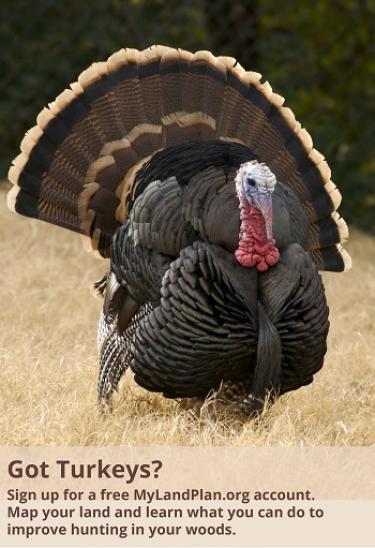How to attract turkeys to your land
The birds on Saloom Properties, a tree farm in southern Alabama, number 120 to 150, estimates its owner, Salem Saloom. Since he purchased the property in the early 1980s, he has managed the land with wildlife in mind, primarily wild turkeys. “When we first started, about 1 percent of the property was open land—wildlife openings. For good turkey habitat, you need a little bit more than that, so we’re up to 5 or 6 percent,” he says. “So it’s an excellent habitat now because we mainly managed it for turkey, and then the deer will come.” In addition to developing wildlife openings, he has thinned timber, planted mast-producing trees, created food plots and practiced prescribed burning to spur the growth of turkey-friendly vegetation.
Using these kinds of techniques to managing a habitat for food, cover and water is the most cost-effective way to increase and sustain wildlife populations, including turkey flocks. Here’s how to get started.
Food
Managing your property’s natural vegetation is preferable—and less expensive—than planting food plots, but plots have their place in supplementing the flock’s diet during stressful times and attracting birds for sighting and hunting.
Managing natural vegetation
The following woodland management activities can help to meet the special needs of wild turkeys:
- Discing (or “strip disking”): Disturbing the soil through shallow tillage (also known as “discing”) stimulates the growth of highly nutritious forage, including native grasses and forbs.
- Mowing: Mowing should go hand-in-hand with discing. Concentrate on edge roads, fire breaks and old fields to remove old-growth grasses and disperses the seeds.
- Thinning and harvesting: Thin your trees to let the desirable ones, such as large, mature, mast-producing and roosting trees, flourish. Also, thin the forest understory. Turkeys prefer an open forest floor covered in leaf litter for easy forage.
- Creating openings: Turkeys like open, brushy space and grasslands rich in forage. Grass-rich areas also provide safer nesting sites. These can be created by clear-cutting one- to five-acre patches through the forest.
- Prescribed burning: One of the most common tools for managing wildlife habitat, controlled burns stimulate the growth of new vegetation, especially seed-producing grasses, forbs, and legumes. They also attract insects.
- Managing for mast: Removing undesirable trees, cultivating desirable ones and planting mast-producing trees can all help nourish and attract wildlife. Ideally, 20 to 30 percent of your woodland should consist of these fruit- and nut-bearing trees. Turkeys love acorns and pecans, as well as dogwoods, huckleberries, blueberries, and other fruits found in the understory.
- Planting food plots: Follow these tips to establish food plots as a supplement to natural forage. Food plots can also be used to increase turkey sightings and harvest success.
- Where: Food plots should be near a mature wooded area, where turkeys roost and forage for mast.
- What: Soybean and corn are good choices because they provide food in winter, as well as specialized crops and turkey-friendly seed mixes, can be purchased through various suppliers, including the NWTF. Be sure to check with a local professional to ensure that none of the crops you plant are considered weeds in your state.
- How much: Plant a food plot for every 25 acres of timber on your property. Plots should be one-half to two acres in size.
Cover
Many of the same habitat management activities mentioned above can also be used to improve cover for turkeys. In particular, turkeys will use areas that have been thinned by selective harvesting and controlled burns for nesting and brood-rearing.
Water
Springs and seeps are an important component of turkey habitat. They not only provide water but also attract insects and provide greens during warm months. In arid areas, developing water catchments, improving riparian habitat and installing water guzzlers are other ways to ensure a flock and adequate water supply.
Learn more about improving habitat for wild turkey by reading this article in Tree Farmer Magazine.
Get help from the NTWF, which has developed a number of regional habitat programs to help private landowners attract wild turkey and other wildlife.
How can I get more tips?
It’s simple! Enter your email below.

